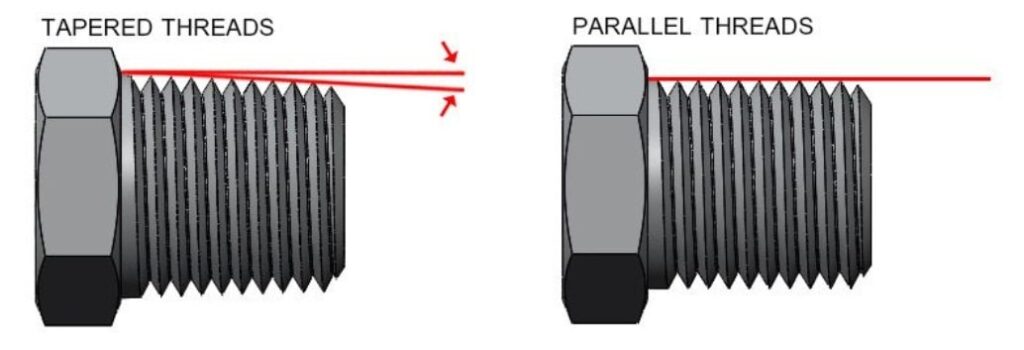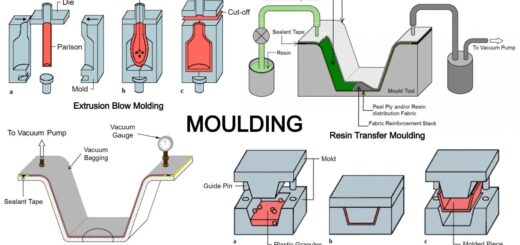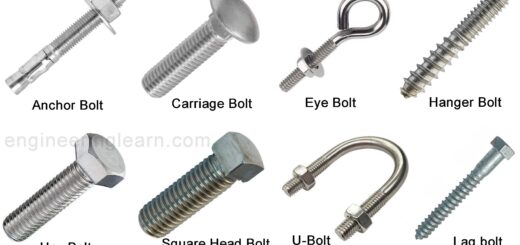13 Types of Threads: Definition, Parts and Thread Identifying Tools [with Images]
![Types of Threads: Definition, Parts and Thread Identifying Tools [with Images]](https://engineeringlearn.com/wp-content/uploads/2021/06/Threads-1024x539.jpg)
Definition of Threads
Types of Threads: Definition, Parts and Thread Identifying Tools [with Images] :- Thread are found having a very critical role in the engineering line specifically for manufacturing various items of day to day life. In the manufacturing industry the machines are used almost at every moment and without threads, almost all the machines are incomplete. Talking in the technical language the spiral grooves of equal measurement or shapes made up of a round cylindrical article or pipe are referred to as threads or in other words, spiral grooves of equal pitch and equal depth which is made on the parallel round cylindrical surface or conical round surface is referred to as threads.
Main Parts of Threads
Generally there are three main parts of the threads are following:
- Shank Diameter
- Thread Per Inch ( TPI)
- To The Point
1. Shank Diameter
Shank diameter is represented by the diameter of the thread as the number goes higher so as the diameter of the threads. Shank size will decide which screw threads is most compatible or ideal with for the specific job.
2. Thread Per Inch ( TPI)
It is generally abbreviated as TPI. This is simply the no of threads found or designed in an inch (1”). Low TPI likes of 7 &8 represent the coarse screw while 18 or 22 provides the fine screw threads for metal fastening.
3. To The Point
The most common types of screw points are self piercing point & self drilling points.
Self Piercing Point :- it has such sharp point designed to cut through the material as the screw thread.
Self Drilling or Drilling Points :- it is equipped with drilling feature at the tip of the screw that is used to bore a hole through the metal before thread engages to fasten the pieces together.
How to Identify Different Types of
Threads?
Before you start, make sure you have two thread identifying tools on hand;
1. Pitch Gauge
A pitch gauge is referred to as an instrument which is used to measure the distance within the crests of threads. For NPT, UN/UNF, BSPP and BSPP the number of threads per inch are measured. In case the observer has the metric threads, then the pitch gauge would identify the distance within each individual crest in millimeters.
2. Caliper
A caliper is referred to as that instrument which is used to measure the diameter of a thread. For the male threads, it is found measuring just the outside diameter whereas for the female thread it measures the inside diameter. For all the advanced users, there is a digital caliper which is available in the market which saves the time and also simplifies the process. ( Types of Vernier Caliper )

A) Difference Between Tapered Thread & Parallel Thread

There are various types of threads, so it important to know all the types of threads along with their features and applications so that while using these instruments a correct type can be selected by the user. Scroll down to know more about the types of threads.
Parallel threads are the threads which include:
- UN/UNF
- BSPP
- Metric parallel
Tapered threads are the threads which include:
- NPT/NPTF
- BSPT
- Metric tapered
In order to identify whether the thread is tapered or parallel one can have a look at the diameter of the thread. In case the thread diameter is found being thinner towards the end then it is confirmed that it is a tapered thread. Whereas in case the thread diameter is found to be same at the top as well as the bottom of the thread then it can be termed as a parallel thread. There is one more way by which you can find out whether it is a parallel thread or tapered thread, if the threads touch the entire length of the calipers then it is surely a parallel thread otherwise it is a tapered thread.
B) Determine the Size
An instrument known as thread pitch gauge tool should be used in order to determine the size of the thread. The thread pitch gauge helps you in accurately measuring and calculating the number of threads within a required distance.
C) Size of the Thread
Whenever it comes to determine the actual size of the thread one should have two approaches. Before starting one must determine whether your thread is a pipe thread (NPT/NPTF, BSPT, BSPP) or not (UN/UNF, Metric Parallel, Metric Tapered). One must note that the tapered thread can be a pipe thread. In case you are found having pipe thread then you can compare the size of the thread with a nominal size profile. If you are working for non-pipe thread (UN/UNF, Metric Parallel, Metric Tapered) then you must use the caliper tools in order to measure the outside diameter of the thread.
4) Designated Thread
These are the steps which involve a designating thread according to the industry standards for further use. Start with identifying the thread size and then note the type and pitch.
13 Different Types of Threads
While coming to types of threads most of the people who work in the industry can recognize the types of threads as almost all these types are used in the industries. Mainly the threads and connections are divided into six types which are as follows:
- UN/UNF
- NPT/NPTF
- BSPP (BSP, parallel)
- BSPT (BSP, tapered)
- Metric parallel
- Metric tapered
There are following 13 different types of threads which are as follows:
- Left-Hand Threads
- Right-Hand Threads
- Taper Threads
- “V” Shape Threads
- Metric or International Threads
- British Standard Threads
- Seller Threads
- Square Threads
- Acme Threads
- buttress Threads
- Worm Threads
- Knuckle Threads
- Single and Multi-Threads
1. Left Hand Threads: ( Types of Threads )
Left hand threads are referred to as those threads which are inclined towards the left hand. These are the ones which are fixed in an anticlockwise movement. For instance threads on a screw with left-hand threads, which are so cut that the bolt, screw or nut have to be turned in a counter-clockwise motion to tighten it. These are the types of threads which are used quite rarely.
2. Right Hand Threads: ( Types of Threads )
Right hand threads are referred to as those threads which are inclined towards the right-hand side. These are fixed in a clockwise movement which are also referred to as right-hand threads.
3. Taper Threads: ( Types of Threads )
Taper threads are the threads which are found having a cut around the taper surface and is thus named as taper thread. These are the threads which can be either right handed or left handed.
The usage of the taper threads are as follows:
- In order to join two or more parts of a machine like nut-bolt and stud.
- In order to get mechanical livers for lifting weights like chain pulleys, jacks etc.
- For higher accuracy in precision instruments like micrometers.
- For jobs of power transfer.
- In order to control or minimize the speed.
4. V-Shape Threads: ( Types of Threads )
V-shape threads are the type of threads which is found in the shape of an English alphabet V. These are the types of threads which are most widely used and can be cut or made by tap, die, lathe machine, milling etc. These threads are found to be made up of various standards.
5. Metric or International Threads: ( Types of Threads )
Metric or international threads are the types of threads which were originally adopted in the year 1898 to 1908 in central France. As the usage increased all the other international countries also started using it. However, the Indian standard institute has also adopted this thread so far.
These are the threads which are made on an angle of 60°. The screw of these type is flat and the root is found to be round. As per the I.S. 1330-1958, the number of threads is 20 per inch and its pitch is 2.5 mm.
6. British Standard Threads: ( Types of Threads )
A) British Standard Whitworth Threads
British standard whit worth threads are the types of threads which was originated from the great Britain and was named after Sir Joseph Whitworth who was a renowned citizen of Great Britain who invented this thread in the year 1841. This is the thread which was used to provide the facility of interchangeability and is used in ordinary nut-bolts and various other jobs. The angle of these threads is 55° and its crest along with the roots are in round shape. These threads are also termed as B.S.W. Thread.
B) British Standard Fine Threads
British standard fine thread are the threads which are quite similar in shape to B.S.W. threads. The angle of this thread is also same as that of BSW thread i.e. 55°, whereas the number of thread per inch is more which means that the thickness of the thread is less. This in turn is responsible for making the grip stronger. Nut bolts comprising of this type of threads are used where is more vibration.
C) British Association Threads
British association threads are the type of thread which is used in small or tiny electrical and mechanical instruments like radio, television, electrical goods, meters and watches. The angle of these types of threads is 471/2° which can easily be used for 1/2″ or 6 mm nut bolts.
D) British Standard Pipe Threads
British standard pipe threads are found having an angle of 55° which cuts at 3/4 taper per foot. These types of threads are used in sanitary pipe fittings, steam pipes, gas pipelines as due to the taper, it does not leak.
7. Seller Thread: ( Types of Threads )
Seller threads are the type of threads which are known by its name of American national thread. These have been recognized by the American standards institute and is a type of V shape thread. These threads are found having an angle of 60° and also have flat roots and crest. The same standard institute was responsible for inventing the national fine thread which is a quite thin thread. These are the threads which are mostly used in the motor vehicles as well as the airplanes.
8. Square Thread: ( Types of Threads )
Square threads are referred to as those threads which are found having very powerful root. It is named in such a way as it is found making the square and these are the threads which are used for lifting heavy loads, transfer of power, exerting pressure, and screw jack and vice spindle instruments. The specific measurement or number per inch of such threads are not particular.
9. Acme Thread: ( Types of Threads )
Acme threads are referred to as those threads which are more or less similar to square threads whereas their shape is in taper like the flat from bottom and thin from the top. In comparison to square threads these are easier to cut it on a job and are also considered stronger. These threads are found having slanting ends and therefore are easier to fix or unscrew the split nut on it but do not have a backlash in it. Acme threads is made up at an angle of 29°.
10. Buttress Thread: ( Types of Threads )
Buttress threads are referred to as the screw threads which has a triangular section but also has one face at the right angle of the axis of the screw and the second face only being sloped. These are the threads which are found having more pulling power as compared to the square thread. This is the only reason why these are used in cases where there is an excessive pull required on one side and which can must be absorbed.
11. Worm Thread: ( Types of Threads )
Worm threads are referred to as those threads which are found to be almost similar to the acme threads whereas are found to be deeper as compared to the acme threads. The angle of worm threads is found to be 29 ° and are named in such a way as they are used in worm wheels of motor vehicles in order to transfer the power at an angle of 90°. As soon as the three teeth of the worm wheel gets fitted into the shaft along with the worm thread, they get properly installed.
12. Knuckle Thread: ( Types of Threads )
Knuckle threads are referred to as those threads which are also quite strong and are used in heavy and light jobs of rough nature. These are the threads which are found having half round at both the root as well as the crest. These threads can also be casted in a mold.
13. Single and Multi-Thread: ( Types of Threads )
Considering a particular piece of work, it is possible to have various types of threads which are found running along with it. Therefore, here are single-threaded screws and multiple or multi-start threaded screws which are important in various piece of works and are highly used. The independent threads are also termed as starts which are found having a single-start, two-start, three-start, etc.
As soon as one turn is completed, round the screw or bolt then there is a movement of one thread wherein the screw is referred to as a single-threaded screw and once there is a movement of more than one thread, the screw can be referred to as a multiple or multi-start threaded screws.
Now considering the case of a three-start thread, in one complete turn, then the thread gets advances three times as far if it is considered as a single thread. Multi-start threads are referred to as those which are used in those cases wherever there is a fast movement or motion required fountain these are the places which are used widely.
Image Source :- Thehopegroup, Cncindexing, Notesandsketches













